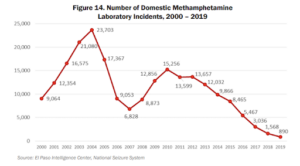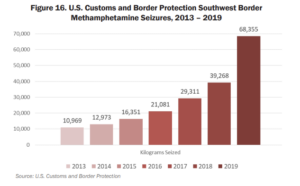When ephedrine was readily available, small clandestine laboratories were found across the country. However, smaller labs have largely been replaced by transnational criminal organizations (TCOs) in Mexico, leading to a steady decline in domestic methamphetamine laboratory incidents, but an increase in seizures at the U.S. – Mexico border. Plus, the DEA reports that “many of the domestic methamphetamine laboratories seized in 2019 were small-capacity production laboratories, known as ‘one-pot’ or ‘shake and bake.’”
Methamphetamine seizures occur in every U.S. state. Mexican TCOs control wholesale methamphetamine distribution, while both Mexican and domestic criminal groups typically control retail distribution in the United States. The SWB remains the main entry point for the majority of methamphetamine entering the United States. Methamphetamine seizures along the SWB increased 74 percent from 2018 (39,268 kilograms) to 2019 (68,355 kilograms) (See Figure 16). Total nationwide methamphetamine seizures increased 77 percent between 2018 (41,396 kilograms) and 2019 (73,351 kilograms). While methamphetamine precursors are often transported via maritime shipments from China and India, finished methamphetamine is commonly trafficked overland across the SWB. Traffickers employ various techniques to transport and conceal methamphetamine, such as using human couriers, parcel services, and commercial conveyances. Commonly, traffickers transport multi-kilogram shipments of methamphetamine in privately owned vehicles. Fuel tank concealment remains a widely used technique with either packaged methamphetamine or methamphetamine in solution. Methamphetamine concealed in tires and other natural voids in vehicles are other popular methods for smuggling methamphetamine and other contraband into the United States.


Mexican TCOs are likely to continue to produce, transport, and distribute high-purity, high potency methamphetamine across the SWB into the United States and will likely continue to adapt their production methods as precursor chemicals become restricted, become temporarily unavailable, or cost-prohibitive. Domestic production will likely continue declining as methamphetamine produced in Mexico remains a lower cost, higher purity, and higher potency alternative. Conversion laboratories will likely continue to increase, or at least maintain a stable presence, as methamphetamine in solution remains an effective concealment and transportation option. Additionally, TCOs are likely to continue to attempt to expand existing markets or establish new ones by offering methamphetamine in nontraditional forms such as tablets. The price of methamphetamine currently remains low compared to other drugs of abuse despite the impact of the COVID-19 pandemic but has seen price increases during the ongoing pandemic. As the COVID-19 pandemic crisis continues, fluctuations in pricing and availability will likely continue with all drugs of abuse, with the methamphetamine market disproportionately affected.